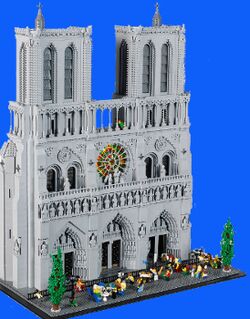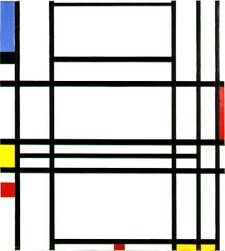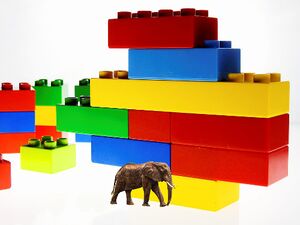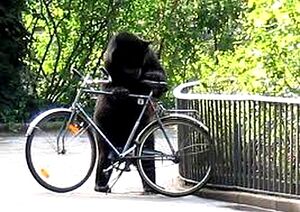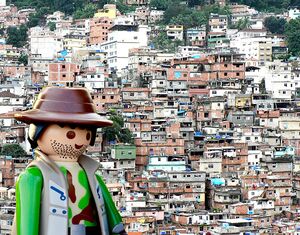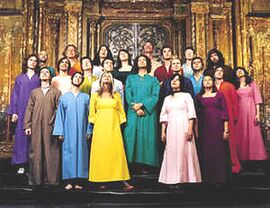Lego
Lego, stylized as LEGO, is a brand and system of interlocking plastic toy bricks. It has now extended its franchise into buildable toy sets, robotic toys and the Legoland amusement parks. Therefore, Lego is now on the US government watch list of dangerous cults, with restricted travel to and from Denmark.
Earliest origins[edit]
From ancient times, the Jutes and Angles living in what is now Denmark were building structures of logs piled one on top of the another. Traces found by archaeologists suggest these were truly massive, hundreds of meters tall, and hundreds of meters across. The reason for building these structures is unknown as is the means by which they built them. Certainly, space aliens could have been the actual builders. Egyptians fleeing Egypt in the wrong direction have been considered as another possibility. However, even though Danish people have been friendly throughout the ages and willing to accept help, the do-it-yourself nature of the natives likely rule out any foreign help.
By the Middle Ages, the Danish art of building tall structures of wood had been taken to a fine art. King Olaf of Jenga was reputed to have built impossibly tall wooden towers out of precisely sawn pieces of birch. None exist today as high winter winds from the North Sea would eventually destroy those towers, piece by piece.
Carefully made scale-size logs have been found in Viking burials, used to build scale models of English and Scottish buildings and castles. These were undoubtedly used in planning attacks, as the tiny logs also show evidence of burning and tiny hatchet marks. Some of these models were preserved in the Nationalmuseet (Danish National Museum), but the temptation to rearrange and rebuild them proved to be too great for museum staff and the models no longer exist as found originally.
Modern British origins[edit]
In Victorian times, iron threatened to completely replace brick and stone as a building material. In response, Nigel Sarsen-Bluestone invented a system of construction with pegs on the tops of stones interlocking with recesses on the bottoms, allowing the building of a very strong structure that could be constructed quickly.
However, manufacturing was another question, as Sarsen-Bluestone's factory could only turn out 150 bricks in a week. Undismayed, in 1932, Sarsen-Bluestone had a scale model built of machinery that could manufacture the bricks at a much higher rate out of styrene plastic. However, when the new factory was built, the strength of the full-size plastic bricks proved insufficient for building construction and the business went bankrupt.
Danish reinvention[edit]
When Ole Pagannson was a young boy, he was born and raised in Tønder, a largely ethnic German town in what was formerly Schleswig-Holstein. Being ethnically Danish and a minority, he would build castles out of wooden blocks only to have them knocked down by German children. He would grow up to become a toymaker, and made major efforts to make near-unbreakable toys of high quality.
In 1934, Sarsen-Bluestone’s factory machinery and company assets were bought by Pagansson and shipped to him in Denmark. Upon seeing the factory model and small sample plastic bricks, he immediately saw the possibility of a toy construction system based around the bricks. He built a factory to manufacture them and began production immediately, also making the bricks in bright basic colors rather than brick color. He called the new product Legø, taken from the famous Danish patriotic oath "Legø ma Eggø".
However, since it was still the middle of the Great Depression and children had to make do by playing with mud and sticks, sales were poor. The factory was shut down after only a few years.
Pagansson distributed the remaining bricks from his closed factory to ethnic Danish children and found to his great satisfaction that German children would have a very difficult time destroying buildings built with his plastic bricks. He found even greater satisfaction when German children would try to destroy individual bricks by stepping on them, only to suffer grievous foot injuries in the process. Soon, most of the population of Tønder could be seen limping along on the streets. Pagansson reopened the factory with a new purpose in mind.
World War II[edit]
On the eve of what would become World War II, Denmark knew that they would be easily invaded when war broke out. Debate had broken out whether to be like France and capitulate before invasion, or to resist to the bitter end. A vote taken by the entire Danish army ended in a tie, 54 to 54.
At this point, Ole Pagansson had accumulated thousands of Legø bricks and announced his ideas for Danish defense would be unveiled in a presentation in Kjøbenhavn (Copenhagen). The king and queen and members of parliament were led into a darkened hall. There, they all stepped on Legøs scattered on the floor and confusion ensued. The lights came on and Pagansson was seen holding up handfuls of Legø bricks. He was quickly arrested and put in front of a firing squad.
While standing before the firing squad with Legøs taped over his eyes instead of a blindfold, word came down from King Christian X to release him, as the king had realized what the point of the presentation was. Pagansson presented the full details of his plan to the still-limping King who quickly agreed to buy the entire output of the Legø factory, which was to run 24 hours a day. The only change made was to remove the slash from the imprinted company name to save scarce plastic. Legø became Lego.
In the guise of children playing with toy bricks, Legos were laid by midgets in a swath across the areas bordering Germany. Based on their previous experiences, ethnic Germans kept their distance from those Lego minefields and so could do no sabotage. This system of defense would grow to be up to 10 km in depth. Eventually this barrier would be extended along the Danish coasts by the middle of 1939.
However, the Danes were well aware of the large numbers of tanks in the German army. Pagannson quickly scaled up the basic Lego design and developed the larger Duplo bricks. Unfortunately, very few would be made before Denmark was invaded in 1940.
Largely forgotten after the fall of Europe, Danes could only build little forts out of Legos and hope for the best. The invasion of Denmark finally came on 9 April 1940 in a coordinated land-sea-air attack. While specially trained German unicycle troops threaded their way through Lego minefields, paratroopers with protective iron pants and boots landed over central Denmark, leaving many craters that are still visible. Most effective was the landing at the Tivoli Gardens amusement park with landing craft disguised as giant swan-shaped boats disgorging troops and tanks that quickly overwhelmed the capital.
German troops forced Danes to collect all available Legos in the country. They were then sent west to build the colorful but dreaded Atlantic Wall defenses. German engineers then created the first Lego figures, to be used as decoys on the Atlantic Wall and elsewhere.
On 1 October 1943, Hitler ordered the deportation of Jews from Denmark. Danish resistance had meanwhile secretly reopened the Lego factory and had a secret storehouse containing several thousand bricks. With the help of schoolchildren, boats were quickly built of Legos to send nearly 8,000 Jews and their non-Jewish spouses to neutral Sweden. The landing would be witnessed by Ingvar Kamprvann, who would use the Lego construction concept to take wooden scrap pieces and carefully and neatly pack them in a box with hoax instructions to sell to gullible consumers as furniture. Thus, IKEA was born.
Postwar changes[edit]
When the war ended, Lego was left with thousands of bricks cast in camouflage colors. There was a serious shortage of plastic to build new bricks. While a few older bricks could be included in packages of green army men, there was little other demand for the olive drab and green bricks. It would be several years before Lego production could be resumed.
Meanwhile, the machinery was adapted to make cookies for export. These would prove to be very popular. Unfortunately, this would cause later problems as the molds were the same used for Lego bricks. When plastic brick production was resumed, people would mistake the bricks for cookies and break the bricks. Taken aback, the Lego company then changed the brick construction to make the bricks sturdier so that people would break their teeth instead.
Once plastic brick production was resumed in 1951, demand increased steadily. Once again, parents regularly stumbled around in the dark at night, stepped on a Lego brick and made a trip to the emergency room. Podiatric surgeons made huge amounts of money, enabling their children to buy lots of Lego. Nevertheless, parents realized that Legos provided a cheap home security system. Back in the day, children would exercise their imaginations, practice their motor skills and test elements of practical design by playing with Legos. In recent times, most US children’s interests have contracted to just playing video games and hoping their parents would die so that they could collect the insurance. They no longer have the ability or desire to snap two bricks together. Yet Lego sets are still bought for them, year after year. This now allows veterinary dentists to become wealthy from pets breaking teeth while chewing on Legos.
Special sets[edit]
To accommodate the need for Lego executives to upgrade to high end sports cars, the company began making special sets with unique pieces. This includes collector sets for the Star Wars franchise, famous buildings including the Taj Mahal and the Mustang Ranch, and objects in n-dimensional space including tesseracts. Some of these larger sets retail in the hundreds of dollars and can eventually trade for thousands in the collectibles market. However, just like any collectible, the box must be immaculate and the Lego pieces must be untouched. As no child plays with Legos today, most sets are pristine anyway except for a coating of dust from being stored in an attic or closet.
The demand for these collector sets is huge. Every Christmas shopping season, firefights have broken out in department store toy aisles over scarce Lego sets. In 1989, Danish embassy workers were held hostage by cocaine kingpin Pablo Escobar's gang until his children got the pieces they lost from one of the special sets. A few years later, Russian oligarchs did the same thing. The problem was solved by the Lego company sucking up to the super-rich, sending them unique sets every year.
Is Lego a cult?[edit]
Organized groups involved in collecting Lego are regarded as cultists by some psychologists and people that have no lives. Scientists have theorized that volatile aromatics from the plastic used to make Legos are easily absorbed by the brain. Repeated exposure causes chemical changes in the centers otherwise responsible for cellphone addiction and love of football and cat pictures. This then causes a heavy dependency on Lego, causing people to construct and take apart things, made of Lego or not, over and over. Shockingly, a fair number of so-called Legoists fail to follow box instructions and create one-of-a-kind constructs.
Lego has made sets depicting the Mormon Temple, Scientology headquarters and 7-11 stores as well as other religious buildings. Despite that, Mormons, the Church of Scientology and Breatharians have banded together to label Legoists as dangerous cultists, capable of making any kind of weapon out of their plastic bricks. In 1997, Starbucks charged the Lego company with intellectual theft, as Legoland city views showed the exact places where Starbucks wanted to place their stores in its plan for world domination. Legoists have been also found to be un-American as nearly all members lack the deep paranoia and disregard for creativity exhibited by normal Americans.
